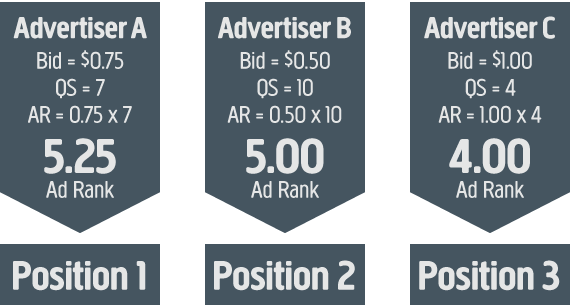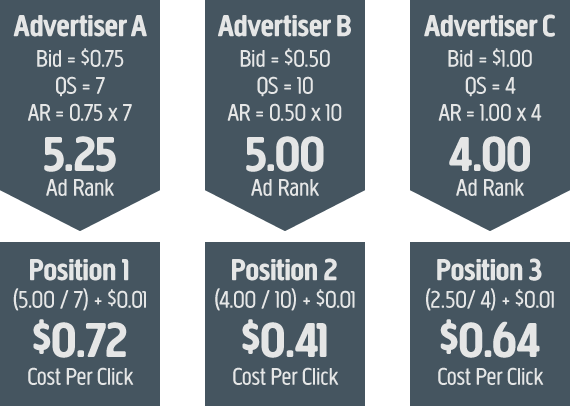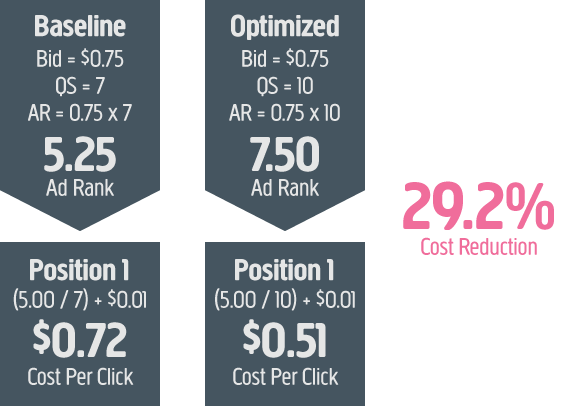Before Google implemented quality scores for search advertising, Google searches were overrun with irrelevant ads that linked to sites with little content. Any marketer could bid on nearly any term and show in the paid results and placement was simple: higher CPC bids equalled higher ad rank. This created an overall poor search experience for the user. Google eventually improved ad quality by being the first search engine to assign quality scores, which attempt to measure ad relevance.
Instead of the highest paid search position being awarded to the highest CPC bidder, Google’s new Ad Rank (AR) is based on both CPC bid and quality score (QS):
AR = Bid x QS
The bid is set by the advertiser, however the quality score is assigned by Google. Although there are a myriad of factors that impact quality score, the four that advertisers can easily control are:
- Relevance of the keyword to the ad copy
- Relevance of the the keyword to the landing page copy
- Relevance of the ad copy to the landing page copy
- Historical click-through rate (Google assumes that if your ad is clicked frequently for a particular search query, the user sees it as relevant)
Although this means significantly more work for the online marketer, it results in a major advantage for the marketer that is willing to do the work. One could use a company like themarketingheaven.com and advertise their social media using a number of techniques to stand above all and mark their existence. Here is an example of three different advertisers bidding on the same search term:

As you can see, the highest bidder (Advertiser C) is going to end up in the first paid search position. Advertiser A’s ad will show first and with a bid that is 25% lower than Advertiser C’s bid.
How much will each advertiser actually pay? The actual cost of each click is determined by the following formula:
Actual Cost = ( Ad Rank of the Position Below / Quality Score of Your Ad ) + $0.01
Here is what each of the advertisers above will actually pay per click:

Although Advertiser A has the highest Cost-Per-Click to be in position #1 in this case, the really interesting observation is the relationship between Advertisers B and C. Advertiser B shows higher in the search results that Advertiser C, yet Advertiser B will pay less than half of what Advertiser C will par per click. This is all due to the fact that Advertiser B has a significantly higher quality score.
Let’s see what would happen if Advertiser A raised his quality score to 10:

If Advertiser A raised his Google Adwords quality score to 10, he would realize a reduction in cost per click of nearly 30%, which could be used to hire a Google AdWords Perth agency to pilot the website. When you are dealing with budgets in the millions of dollars annually, that could make an enormous impact on the bottom line.
So now you know that higher quality scores lead to better rankings and lower advertising costs. Here are the simple things you can do right now to improve your Google Adwords quality scores:
- Reorganize your campaigns into small, tightly targeted ad groups for improved relevance
- Write targeted ads that include your target keyword in the title, body, and URL (if possible)
- Utilize multiple landing pages. The landing page should have a significant density of your target keywords for a particular ad group. If all of your ads point to your home page, you are probably doing it wrong.
- Include a clear call to action in your ad copy. This improves Click-Thru-Rate which improves quality scores over time.
Improved Relevance
= More Clicks at Lower CPC
= More Conversions at Lower CPA
= Higher ROI on Your Ad Budget.
Now get to work…
UPDATE: Thanks to Tom for pointing out a typo in the diagram; last column QS and AR should have been 4.0, not 3.0


I have an Adwords account that has been up for a while now for my site but most of the ads have poor quality scores. I have been thinking of making major changes and your article is exactly inline with I want to do. Is it best to open a whole new Adwords account and start fresh? I read somewhere that Google will continue to penalize you for old poor quality scores. I thought I might be able to avoid that with a new Adwords account. What do you think? Thank you in advance.
David, it really depends on how long you’ve had your site, what your other quality scores are, and many other things. I’d suggest reading the Google help article on Adwords quality scores to better understand how they’re calculated. If you’re consistently seeing lower scores even after making drastic ad and landing page changes that are accurate and should bump the score up, you may want to consider a new account. Check out the article here: http://support.google.com/adwords/bin/answer.py?hl=en&answer=10215
Great post Scott, thanks. I might be missing something but it looks like the Ad Rank for Advertiser C should be 4.0 rather than 3.0 if their bid is $1.
Good catch, Tom. We just updated the post. The cost calculation comes out the same.
Hi,
I have some ‘buts’
first of all sorry for my english;/
tom pointed that ad rank for C should be 4.0, you”ve changed that but havent calculations at postion 2.
now I heve 2 question
1. why you assumed that AD RANK OF THE POSITION BELOW advertisent C is 2,5? what if there is noone else?
2. What if there is a draw in ad position, what matters most QS or bid?
1. The ad rank of the position below is just an example for illustration purposes. All I know is that the ad rank would have to be less than 3.00 or that ad would show higher.
According to Google, if there is not an advertiser below your ad:
“If your ad is showing in the last position, or if it’s the only ad showing:
In this case, a click costs the lowest price possible for your ad to be eligible to show. This price depends on the matched keyword’s Quality Score: the higher the Quality Score, the less you pay, and vice versa.” http://support.google.com/adwords/bin/answer.py?hl=en&answer=87411
2. In the case of a tie, it appears that historical CTR determines the winner.
Excellent post. In cost per click calculation for position 2, I think the AR should be 4, not 3. (4 / 10) + 0.01 = 0.41
Great catch Vasu, we had used this example previously with different data and totally missed updating that value. Thanks!
hey scott, I want to do some SEO on my blog. would you suggest me what should i do. i’ve created adword account but don’t know how to use it. will you please help me.
thanx in advance :-)
Bruce. As far as SEO – best place to start is Moz.com/beginners-guide-to-seo
As far as setting up Adwords – we wrote a good setup guide on how to do that correctly here: http://vuurr.com/6-steps-to-setup-basic-adwords-campaign/
Cheers
Thank you Chuck ;-)